Hi Hive Blog folks, sorry for the delay, you sent me an overwhelming amount of homework in high school and I didn't have time to upload a new post but thank God I'm done, and today I present to you these character drawings inspired by Venezuelan foods! !


Estos dibujos son originales míos (hasta dónde sé) pues me llegó la idea de hacerlos mientras comía mi almuerzo;una arepa con queso y mantequilla,¡mi favorita!.
Me tomó bastante tiempo pues estaba haciendo personajes de la nada;estaba transfiriendo los personajes de mi mente a la hoja.
Tengo entendido de que hay trabajos donde tienes que dibujar personajes y para crearlos tienes que dibujar un diseño y otro hasta conseguir el que quieres,ó si no es tuyo,el del autor original.
No es primera vez haciendo diseños pero no es que fueran de mi agrado sinceramente,horita es que estoy agarrandole cariño a esta forma de dibujar al igual que hacer guiones no eran ni mi fuerte ni tampoco lo que me gustaba le vengo a agarrar gusto después de saber la historia de One el creador de One Punch Man,me motivó no solo con los guiones si no también a esforzarme con los cómics,los que ya habrán leído mi primer y antiguo Post jeje sabrán de que a mí me gusta todo esto de los cómics, guiones, dibujos (aunque no se crean que estoy actualizado sobre el mundo de los cómics y todo sobre éste tema, ni siquiera el de internet jajaj casi me pierdo Poppy Playtime),poco dibujo personajes que no sean mios,me gusta más el de crear y hacer personajes de mi propia imaginación.
Aprovechando de que estamos en Navidad hice un dibujo inspirado de la hallaca,primero que todo,para los que no sepan que es una hallaca les contaré la historia o las historias de este platillo muy delicioso:
La hallaca es un plato tradicional navideño en Venezuela y se ha convertido en una comida típica como la arepa, el pabellón criollo y el asado negro.
El origen de la hallaca se remonta entre el siglo XV y fue creada por los sirvientes indígenas, que recogían los sobras de comida y elaboraban un plato que les servía de alimento extra a sus comidas habituales.
Existe otra versión que cuando se estaban construyendo el Camino real por los indios. Estos últimos comían bollos de maíz y le pedían a las familias caraqueñas, que donarán las sobras de comida a los indígenas, para que estos lo añadieran a sus comidas.
De esta manera, se originó el platillo que cada año se sirve en las mesas venezolanas durante la época de navidad.
La hallaca es muy similar al popular tamal mexicano, pero la diferencia entre ambos está en el sabor particular de cada uno. Y su nombre proviene del guaraní “ayúa” o “ayuar”, que significa mezclar o revolver.
These drawings are original of mine (as far as I know) because I got the idea to make them while eating my lunch, an arepa with cheese and butter, my favorite !.
It took me a long time as I was making characters out of thin air; I was transferring the characters from my mind to the sheet.
I understand that there are jobs where you have to draw characters and to create them you have to draw one design and another until you get the one you want, or if it is not yours, the original author's.
It is not the first time making designs but it is not that I honestly liked them, now I am taking love to this way of drawing as well as making scripts were neither my strength nor what I liked. Knowing the story of One, the creator of One Punch Man, motivated me not only with the scripts but also to make an effort with the comics, those who will have already read my first and old Post hehe will know that I like all this about the comics, scripts, drawings (even if you don't think I'm up to date on the world of comics and everything about this topic, not even the internet hahaha I almost missed Poppy Playtime), I don't draw characters other than mine, I like the to create and make characters of my own imagination.
Taking advantage of the fact that we are at Christmas, I made an inspired drawing of the Hallaca, first of all, for those who do not know that it is a Hallaca, I will tell you the story or the stories of this very delicious dish:
The Hallaca is a traditional Christmas dish in Venezuela and has become a typical food such as the arepa, the Creole pavilion and the black roast.
The origin of the Hallaca dates back to the 15th century and was created by indigenous servants, who collected the leftovers of food and made a dish that served as extra food for their usual meals.
There is another version that when the Camino Real was being built by the Indians. The latter ate corn buns and asked the families of Caracas to donate leftover food to the indigenous people, so that they could add it to their meals.
In this way, the dish that is served on Venezuelan tables during the Christmas season was originated.
The Halca is very similar to the popular Mexican tamale, but the difference between the two is in the particular flavor of each one. And its name comes from the Guaraní "ayúa" or "ayuar", which means to mix or stir.
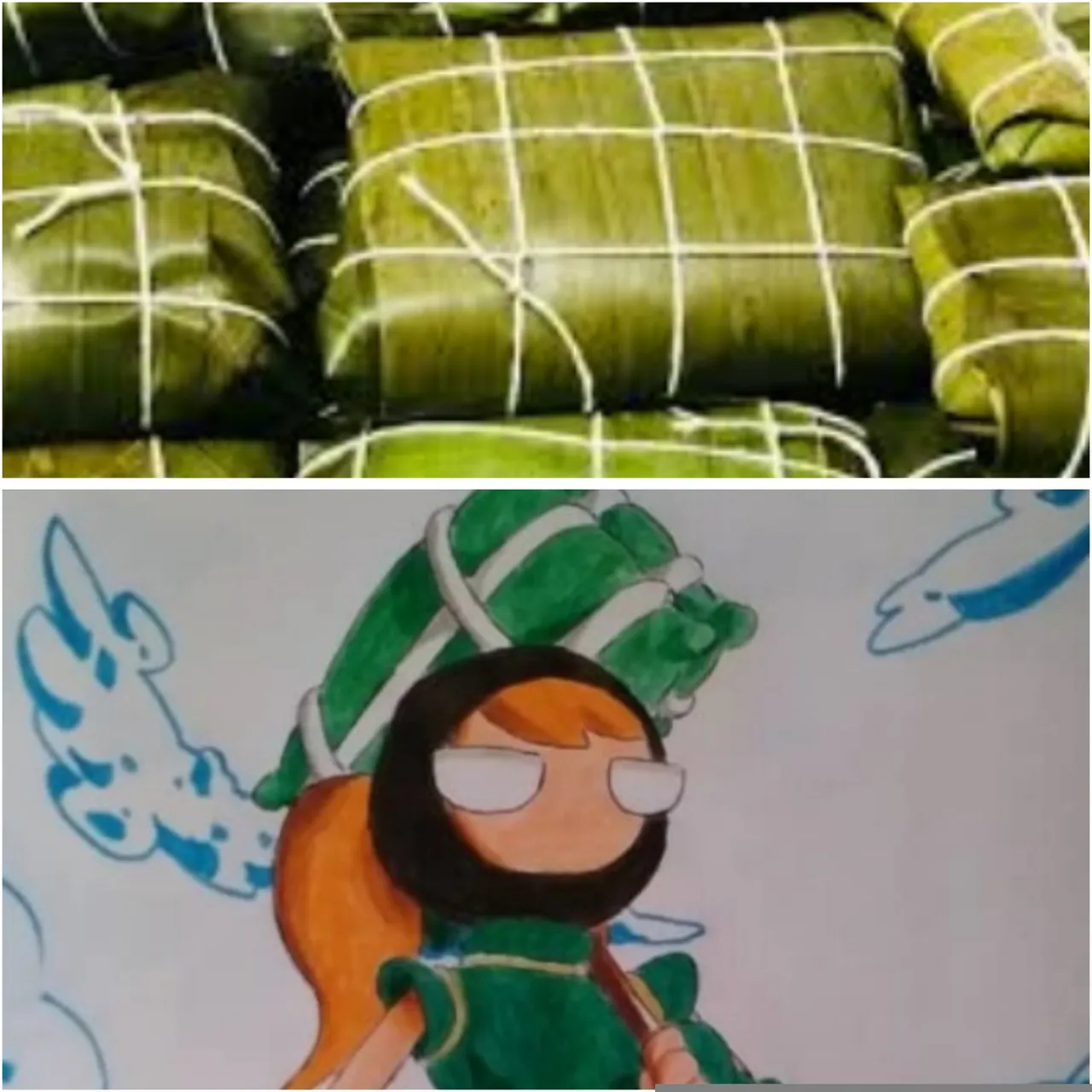
Bien para los que no sabían qué era la hallaca y cómo es ya pueden entender el primer dibujo.
Antes de que pase a hablar del segundo dibujo les voy a mostrar cómo dibujarlo o mejor dicho cómo dibujarla.
Good for those who did not know what the sacaca was and what it is like, they can already understand the first drawing.
Before I go on to talk about the second drawing, I am going to show you how to draw it or rather how to draw it.
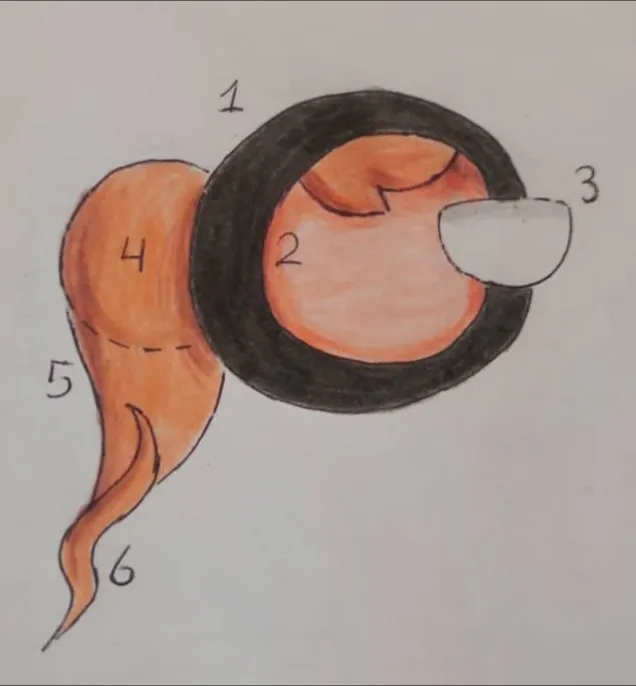
- 1 es una esfera no es necesario hacerla perfecta... o bueno la mía yo no la hice perfectamente
- 2 es un circulo el mechón de pelo, es cortesía de la casa ,dibujen tal cual esa parte es fácil
- 3 es un óvalo picado por la mitad
- 4 una esfera
- 5 es... cómo les digo,no es una forma geométrica, digámosle un cono torcido... si de que otra forma puedo llamarle y peor es la que viene
- 6 es un rayo curvo,ya saben como los que se dibujan popularmente,para ser más específico el que tiene Flash pero sin nada puntiagudo solo curvo como una serpiente
- 1 is a sphere, it is not necessary to make it perfect ... or well, mine I did not make it perfectly
- 2 the lock of hair is a circle, it is courtesy of the house, draw as it is that part is easy
- 3 is an oval cut in half
- 4 a sphere
- 5 is ... how do I tell you, it is not a geometric shape, let's call it a crooked cone ... if what other way can I call it and worse is the one that comes
- 6 is a curved ray, you know how the ones that are popularly drawn, to be more specific the one with Flash but without anything pointed, only curved like a snake
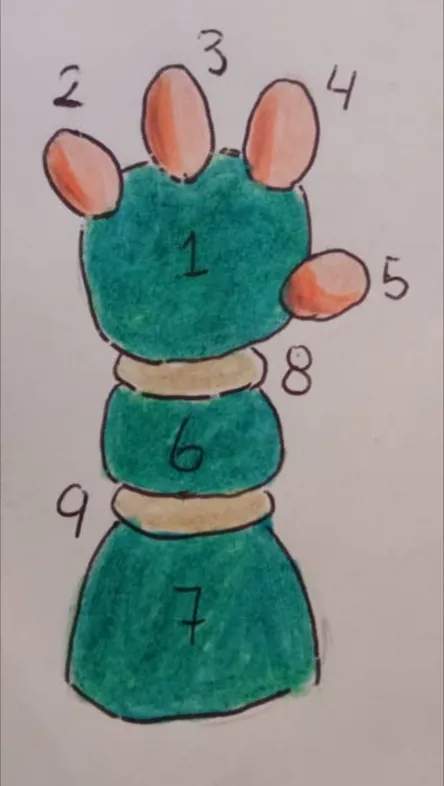
- Nos vamos a la mano,1 es un cuadrado redondeado
- 2,3,4,5 son óvalos
- 6 es una masa y 7 una forma de taza larga puedo ver
- 9 y 8 son cuerdas que van alrededor del brazo
- We go to the hand, 1 is a rounded square
- 2,3,4,5 are ovals
- 6 is a dough and 7 is a long cup shape I can see
- 9 and 8 are strings that go around the arm
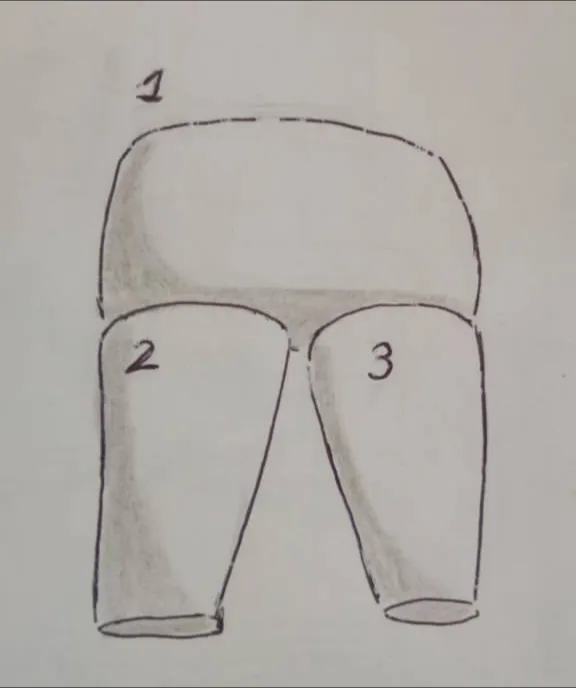
- 1 es un bloque con las partes superiores con menos distancias de una esquina a la otra y la inferior con las esquinas más alejadas entre sí,yo uso está figura (no sé si tendrá nombre y yo aquí como un burro escribiendo las características de esta figura)para dibujar las caderas de las mujeres
- 2 y 3 son cilindros con las partes inferiores delgadas,osea en la parte superior empiezan gordas y a medida que van llegando a la inferior se van poniendo delgadas
- 1 is a block with the upper parts with less distances from one corner to the other and the lower one with the corners farthest from each other, I use this figure (I don't know if it will have a name and I here like a donkey writing the characteristics of this figure) to draw women's hips
- 2 and 3 are cylinders with thin lower parts, that is, in the upper part they start fat and as they get to the lower part they get thin
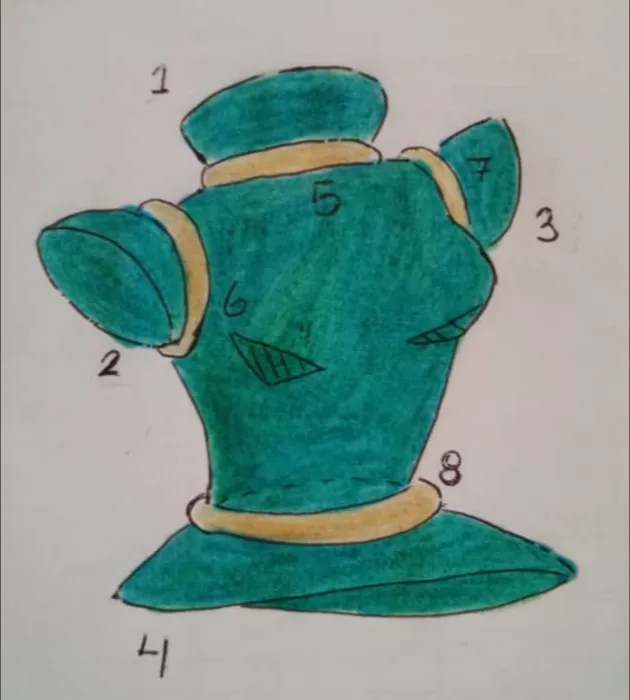
- 1,2 y 3 son taza verde
- 4 una taza muy alargada
- 5,6,7 y 8 son cuerdas (pabilo)de amarrar hallaca,envuelvanlas alrededor de cada taza
- 1,2 and 3 are green cup
- 4 a very elongated cup
- 5,6,7 and 8 are cords (wick) to tie Halca, wrap them around each cup
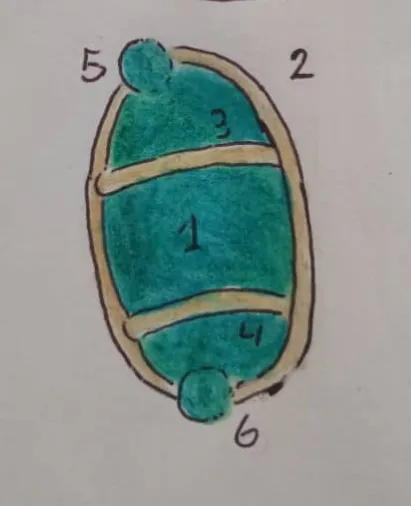
- La hallaca de munición que tiene esta chica se dibuja así,1 es un óvalo
- 2 es una cuerda que dibujarán alrededor del óvalo
- 3 y 4 son cuerdas dibujadas en forma horizontal ligeramente encorvadas para darle ese toque 3D al dibujo siempre es necesario imaginar lo más posible al dibujo 3D
- El martillo hecho de hallaca lo dibujé como si fuera una hallaca nada más pero en realidad son dos que van amarradas,1 un óvalo apretado,es necesario dibujar redonda cada parte "cuadrada",es decir donde se encuentran las dos cuerdas ( horizontal y vertical),hay
nueve espacios cuadrados
- The ammunition box that this girl has is drawn like this, 1 is an oval
- 2 is a string that they will draw around the oval
- 3 and 4 are strings drawn horizontally slightly bent to give that 3D touch to the drawing, it is always necessary to imagine the 3D drawing as much as possible
- I drew the hammer made of Halca as if it were just a Hallaca, but in reality there are two that are tied together, 1 a tight oval, it is necessary to draw each "square" part round, that is, where the two strings meet (horizontal and vertical), there are
nine square spaces
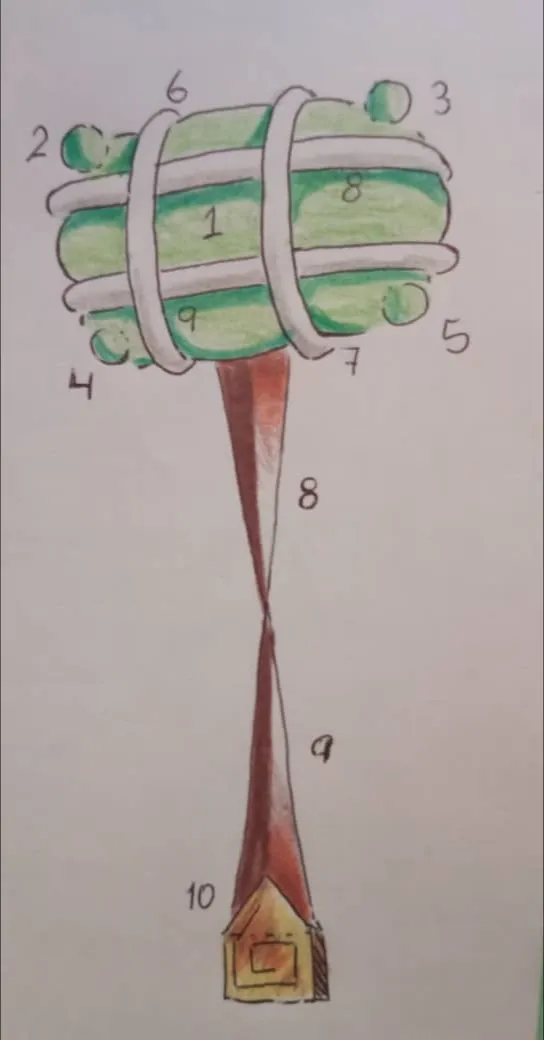
- 1 es un óvalo apretado por los espacios cuadrados consecuencia de las cuerdas llamadas pabilo que son las que se usan para amarrar las hallacas
- 2,3,4 y 5 son esferas estás deben unirse con el óvalo
- 6 y 7 son las cuerdas verticales
- 8 y 9 son las cuerdas horizontales
- También 8 y 9 son dos triángulos que conectan entre sí por medio de la punta ( parte superior y no pregunten por qué le puse 8 y 9 a la vara del martillo o al cuello no sé cómo se dice )
- 10 es la forma de una casita primero un triángulo en la parte superior de la casita y para la parte inferior un cuadrado
- 1 is an oval squeezed by the square spaces as a consequence of the strings called wick which are used to tie the sacacas
- 2,3,4 and 5 are spheres, they must join with the oval
- 6 and 7 are the vertical strings
- 8 and 9 are the horizontal strings
- Also 8 and 9 are two triangles that connect to each other by means of the tip (upper part and do not ask why I put 8 and 9 to the hammer rod or to the neck I don't know how to say it)
- 10 is the shape of a house, first a triangle in the upper part of the house and for the lower part a square

- 1 una taza
- 2 y 3 son cubos redondeados
- 4,5,6,7 y 9 son cuerdas (está última en forma de X)
- 8 es la esfera que compone la mitad del zapato
- 10 es un huevo, tanto la esfera como el huevo se cortaran por la mitad
- 11 es la suela que se pondrá en el vacío que dejo el corte por la mitad
- 12 es un corte que se hará un poco más hacia la derecha por debajo de la cuerda con forma de X dejando la forma de un triángulo ( si no sé entiede se puede ver la imagen)
- 1 a cup
- 2 and 3 are rounded cubes
- 4,5,6,7 and 9 are strings (the last one in the shape of an X)
- 8 is the sphere that makes up the middle of the shoe
- 10 is an egg, both the sphere and the egg will be cut in half
- 11 is the sole that will be put in the void that left the cut in half
- 12 is a cut that will be made a little more to the right below the X-shaped rope, leaving the shape of a triangle (if I don't know how to understand it, you can see the image)

- Está es sencilla solo es una correa,esta sostiene a la hallaca de munición,1 es un tubo hueco
- This is simple, it is only a strap, it holds the ammunition box, 1 is a hollow tube
Bien espero que les haya podido explicar bien como dibujarla a partir de figuras geométricas y no geométricas ,no soy tan bueno explicando,dibujar,todos tienen una forma diferente de hacerlo y les voy a decir de una vez que, estos ejemplos que acaban de ver no son el método Universal ,hay muchas formas de dibujar un cuerpo humano,animal,o un robot, automóviles, objetos de la vida cotidiana,paisajes etcétera.Todos ellos pueden tener un grado de realismo según sea el gusto del dibujante y su capacidad y experiencia para dibujar o mejor dicho para reflejar y crear un universo del tamaño de la hoja o de donde sea que se está dibujando, (créanme yo he dibujado hasta en una "hoja"... de árbol con un alambre) se establece las figuras en el espacio hasta que todas forman lo que el creador está intentando dibujar.
Las técnicas para dibujar o crear una obra de arte nunca termainan, la mía es sencilla... simplemente divertirse y sentirse que ya se a aprendido a dibujar claro siempre queriendo mejorar pero no a quejarse de que ¡el dibujo de un perro que hice parece más a un trozo de un coco podrido!, no se desesperen ni se rindan valoren a sus creaciones e irán mejorando poco a poco
El segundo dibujo está inspirado en una arepa con mantequilla la arepas en cada mano del chico son armas laser.
Las arepas son un platillo delicioso y tradicionales Aquí les muestro un resumen de la historia de la arepa:
Según varios historiadores y datos arqueológicos, el origen de la arepa se inicia hace unos 3.000 años en los territorios indígenas que compartían Colombia y Venezuela en la antigüedad. La preparación de la arepa fue el resultado de la producción del maíz, alimento esencial de los pueblos indígenas en el continente americano.
En el territorio actual de Venezuela, las tribus cultivaban varios tipos de maíz, el blanco, para asar, blanco y negro, maíz largo, color ceniza y el llamado por los españoles maíz cariaco, mientras que los cumanagotos lo llamaban erepa, lo que pudo dar origen al nombre de arepa.
En 1548, el contador del rey en Venezuela, Pedro Ruiz de Tapia, señalaba que las arepas de maíz era la comida de los indios para el almuerzo y la cena.
En 1554, el conquistador español, cronista e historiador del mundo andino, Pedro Cieza de León, en su obra Crónica del Perú, cuya segunda parte, El señorío de los Incas, publicada en 1871, registra el consumo de la arepa en la provincia de Cartagena.
En 1626, el franciscano español, profesor y cronista, Pedro Simón, en sus Noticias historiales de las conquistas de Tierra Firme en las Indias Occidentales de 1626, registra el consumo de arepas en la actual Venezuela.
Dato: En Colombia hay registros de la existencia del maíz de hace unos 3.000 años, mientras que en Venezuela, es de unos 2.800 años. Pero, esto no puede asegurar que el origen de la arepa sea colombiano, ya que la arepa como se conoce en la actualidad pudo originarse años después.
Lo que sí es seguro, es que el origen de la arepa es indígena.
Well I hope that I have been able to explain well how to draw it from geometric and non-geometric figures, I am not that good at explaining, drawing, everyone has a different way of doing it and I am going to tell you at once that these examples that you have just seen They are not the Universal method, there are many ways to draw a human body, animal, or a robot, automobiles, objects of daily life, landscapes etc. All of them can have a degree of realism according to the taste of the draftsman and his capacity and experience to draw or rather to reflect and create a universe the size of the leaf or wherever it is being drawn, (believe me I have even drawn on a "leaf" ... of a tree with a wire) the figures are established in space until they all form what the creator is trying to draw.
The techniques to draw or create a work of art never end, mine is simple ... just have fun and feel that I have already learned to draw clearly always wanting to improve but not to complain that the drawing of a dog that I made seems more to a piece of a rotten coconut!, do not despair or give up value your creations and you will improve little by little.
The second drawing is inspired by an arepa with butter. The arepas in each hand of the boy are laser weapons.
Arepas are a delicious and traditional dish. Here I show you a summary of the history of the arepa:
According to various historians and archaeological data, the origin of the arepa begins about 3,000 years ago in the indigenous territories that Colombia and Venezuela shared in ancient times. > The preparation of the arepa was the result of the production of corn, an essential food of the indigenous peoples of the American continent.
In the current territory of Venezuela, the tribes cultivated various types of corn, white, for roasting, black and white, long corn, ash-colored and called by the Spanish corn cariaco, while the Cumanagotos called it erepa, which could give origin to the name of arepa.
In 1548, the king's accountant in Venezuela, Pedro Ruiz de Tapia, pointed out that corn arepas were the food of the Indians for lunch and dinner.
In 1554, the Spanish conqueror, chronicler and historian of the Andean world, Pedro Cieza de León, in his work Chronicle of Peru, the second part of which, El Señorío de los Incas, published in 1871, records the consumption of the arepa in the province of Cartagena.
In 1626, the Spanish Franciscan, professor and chronicler, Pedro Simón, in his Historical News of the conquests of Tierra Firme in the West Indies of 1626, records the consumption of arepas in present-day Venezuela.
Fact: In Colombia there are records of the existence of corn from about 3,000 years ago, while in Venezuela, it is about 2,800 years old. But, this cannot ensure that the origin of the arepa is Colombian, since the arepa as it is known today could originate years later.
What is certain is that the arepa's origin is indigenous.
Bien ahora es el turno de el segundo dibujo
** Well now it's the turn of the second drawing **
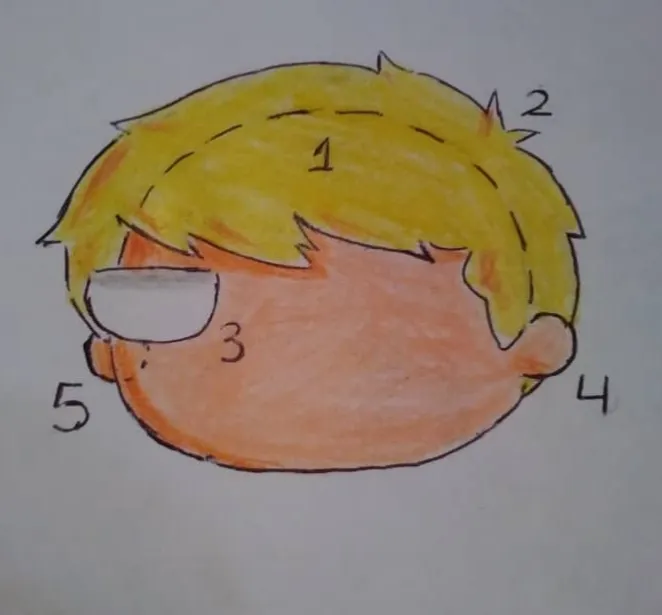
- 1 es un circulo o esfera
- 2 es el pelo,dibujenlo como ustedes quieran ( y cuando me refiero a dibujar como quieran es de que no van a romperse la cabeza copiando el pelo rubio tal cual sino lo más parecido posible ¡ apuesto que ya se lo iban a pintar de morado! Jejeje... ) solo respetando lo dos mechones de pelo en donde se encuentra escrito el 2
- 3 es un óvalo picado por la mitad
- 4 y 5 son esferas
- 1 is a circle or sphere
- 2 is the hair, draw it however you want (and when I mean to draw as you want, it is that you are not going to break your head copying the blonde hair as it is, but rather as similar as possible, I bet you were already going to paint it purple Hehehe ...) just respecting the two strands of hair where the 2 is written
- 3 is an oval cut in half
- 4 and 5 are spheres

- Aquí aprovechando el momento les muestro como dibujo las caderas de un hombre,1 es una taza
- 2 y 3 cilindros
- Here, taking advantage of the moment, I show you how I draw a man's hips, 1 is a cup
- 2 and 3 cylinders
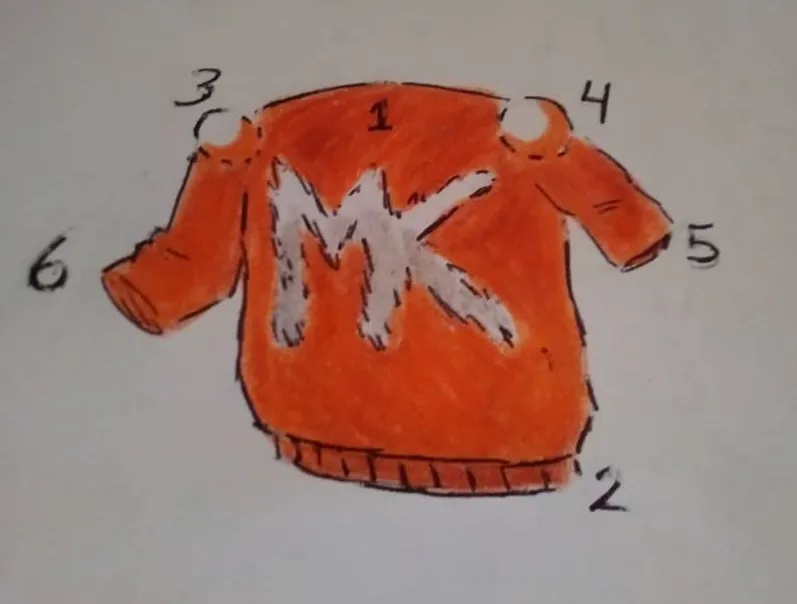
- 1 es un cubo que después irán dalndole sus respectivas arrugas (conforme a la pose y a los dobleces que hayan se añadirán las arrugas que por cierto las más grandes y curvas siempre se dirige hacia abajo y las cortas y rectas hacia arriba)
- 2 es la goma del suéter,un anillo con líneas verticales por dentro
- 3 y 4 son esferas que se unirán con el cubo ó el suéter
- 5 y 6 son los brazos de espagueti pero con las arrugas del suéter ( cuando hagan un dibujo jueguen con el y sus componentes,para la ropa en este caso juege con el realismo de las arrugas de la ropa y el cartoon del diseño )
- 1 is a cube that will then be given their respective wrinkles (according to the pose and the folds that there are, the wrinkles will be added, by the way, the largest and curved ones always go downwards and the short and straight ones upwards)
- 2 is the elastic of the sweater, a ring with vertical lines inside
- 3 and 4 are spheres that will join with the cube or the sweater
- 5 and 6 are the spaghetti arms but with the wrinkles of the sweater (when making a drawing, play with it and its components, for the clothes in this case play with the realism of the wrinkles of the clothes and the cartoon of the design)

- El zapato, el 1 es un escaleno
- 2 un cuadrado
- 3 dibujen una zuela ( rectángulo que en el talón es más grueso)
- Y 4 un puente que sería el dobles antes de llegar al talón
- The shoe, the 1 is a scalene
- 2 a square
- 3 draw a zuela (rectangle that is thicker on the heel)
- And 4 a bridge that would be the double before reaching the heel
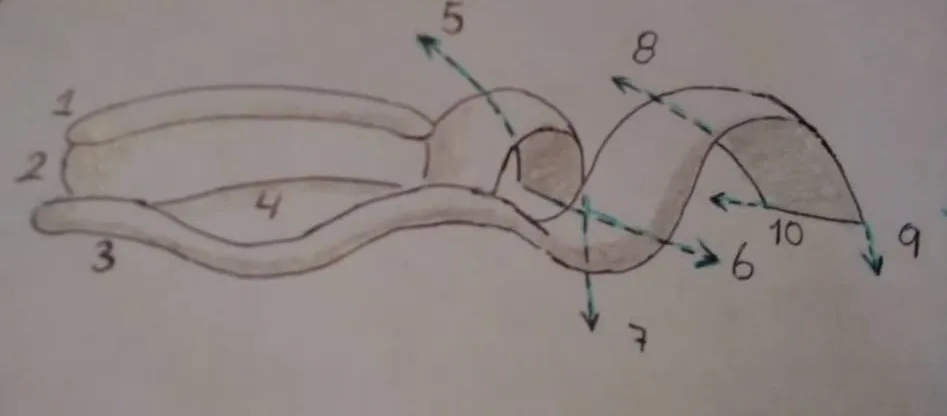
- 1 es una masa alargada cómo si fuera la de un pan francés ! apunte de meteir a la horne ! Jejeje bueno ahora viene
- 2 la misma masa pero aplastada... y en consecuencia más ancha
- 3 pero más delgada y alargada y termina en lo que parece un laberinto sin fin,déjenlo hasta ahí un momento
- 4 es un espacio con una forma como de ojo que queda todo eso es la bufanda de el chico,esas figuras se deben borrar con sumo cuidado (guiarse por la imagen del dibujo
finalizado) - 5 el brazo izquierdo de la bufanda se asemeja a un puente, solo sigan las líneas
- Las lineas de la izquierda superior y la inferior conectan entre sí para después llegar en una sola con el 7 (más que un puente parece una garra)
- en la parte oscura se hace la línea que salta inclinadamente,esa es el 5
- el 6 es la línea horizontal que conecta con el 5 y 7
- ahora sí se puede continuar con la masa del pan francés más larga y delgada, el 3. Emergen dos líneas que hacen la forma de un puente, éstas se une y se vuelven una línea que va hacia abajo,esa es la 9
- aquí sucede lo mismo que con el 5,en la parte oscura salta inclinadamente una línea esa es la 8
- 10 es la línea o flecha horizontal que conecta con el 9 y el 8
- 1 is an elongated dough as if it were that of a French bread! aim to put in the oven! Hehehe well now it comes
- 2 the same mass but squashed ... and consequently wider
- 3 but thinner and longer and ends in what seems like an endless maze, leave it there for a moment
- 4 is a space with a shape like an eye that remains all that is the boy's scarf, these figures must be erased with great care (be guided by the image of the drawing
finalized)- 5 the left arm of the scarf resembles a jumper, just follow the lines
- The lines on the upper and lower left connect to each other and then arrive in one with the 7 (more than a bridge it looks like a claw)
- in the dark part the line that jumps steeply is made, that is the 5
- 6 is the horizontal line that connects with 5 and 7
- Now you can continue with the longer and thinner French bread dough, number 3. Two lines emerge that make the shape of a bridge, they join and become a line that goes down, that is 9
- Here the same thing happens as with 5, in the dark part a line jumps inclined that is 8
- 10 is the horizontal line or arrow that connects with 9 and 8

- Está no es el diseño definitivo en un futuro Post lanzaré si Dios quiere el diseño definitivo...pero bueno la 1
es la forma de una esmeralda cómo las de Clash Royale( la amarilla con rayas parecido a las de un tigre son lo quemado de las arepas) - 2 es un anillo con rayas
- 3 es una taza con dos ojos
- la 4 y la 5 son unos rectángulo que se cortan inclinadamente hacia la derecha apuntando a abajo
- 6 es el cachete superior de la arepa se dibuja una masa redondita
- 7 es el cachete inferior de esta deliciosa arma
- 8,9 y 10 son un rectángulo pequeño que en las puntas de cada esquina se hace una línea que se pierde al interior de la arepa,con cuadros amarillos ( ver imagen)
- This is not the final design in a future Post I will launch if God wants the final design ... but hey the
1 It is the shape of an emerald like those of Clash Royale (the yellow with stripes similar to those of a tiger are the burnt of the arepas)- 2 is a striped ring
- 3 is a cup with two eyes
- 4 and 5 are rectangles that are cut at an angle to the right pointing down
- 6 is the upper cheek of the arepa, a round dough is drawn
- 7 is the lower cheek of this delicious weapon
- 8,9 and 10 are a small rectangle that makes a line at the ends of each corner that is lost inside the arepa, with yellow squares (see image)
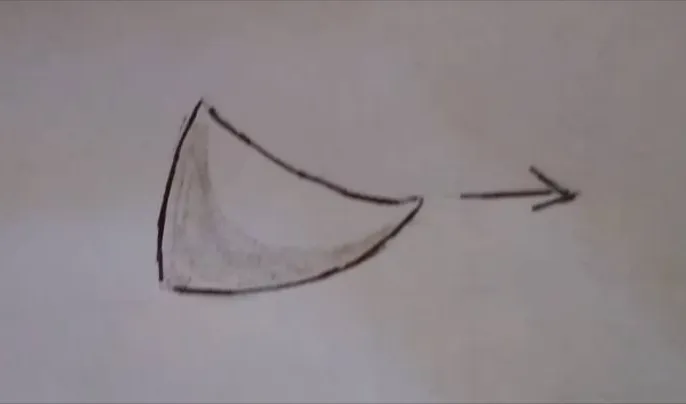
- Este colmillo es el queso,la punta va adentro que no se vea;no la puse en la imagen anterior porque el queso lo pondrán ustedes a su gusto
- This tusk is the cheese, the tip goes inside that is not visible; I did not put it in the previous image because you will put the cheese to your liking
Bien este fue el último por este post, como ya había dicho espero que mis explicaciones hayan servido para darles una idea no es necesario seguir las instrucciones al pie de la letra(yo dibujo de una forma diferente con figuras geométricas y otras no geométricas),en una oportunidad haciendo el dibujo de un dragón (que ya está apunto de aparecer en el próximo post),lo dibujé hantes de hacer las tareas y como duré mucho tiempo sin dibujarlo por culpa de las tareas cuando terminé todas las tareas me puse a dibujarlo en otra hoja y mi sorpresa fue que no supe cómo hacerlo,el pico parecía que le hubiesen dado un solo guantazo jajaja tuve que remarcar el boceto.
Yo después que hago el boceto lo relleno de puras figuras sencillas de captar y ya se podrán imaginar cómo sufrí remarcando con el bolígrafo en esa jungla de puro grafito pero bueno espero que les haya gustado y disculpen la demora gracias por ver.
Well this was the last one for this post, as I had already said, I hope my explanations have served to give you an idea, it is not necessary to follow the instructions to the letter (I draw in a different way with geometric figures and other non-geometric ones), on one occasion drawing a dragon (which is about to appear in the next post), I drew it before doing the tasks and since I did not draw for a long time because of the tasks when I finished all the tasks I started to draw it on another sheet and my surprise was that I didn't know how to do it, the beak looked like it had just been slapped hahaha I had to highlight the sketch.
After I make the sketch, I fill it with pure figures that are easy to capture and you can imagine how I suffered remarking with the pen in that jungle of pure graphite but hey, I hope you liked it and excuse the delay, thank you for watching.
CHAO 🙋
CHAO 🙋
CHAO 🙋
CHAO 🙋
CHAO 🙋
CHAO 🙋
BYE 🙋
BYE 🙋
BYE 🙋
BYE 🙋
BYE 🙋
BYE 🙋